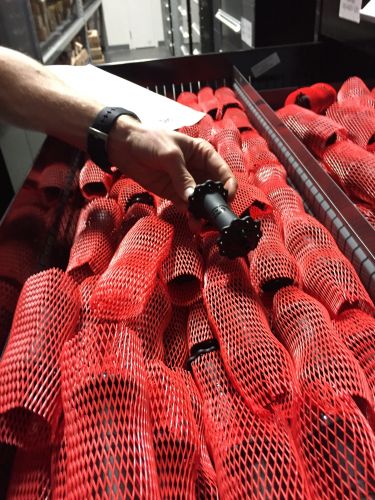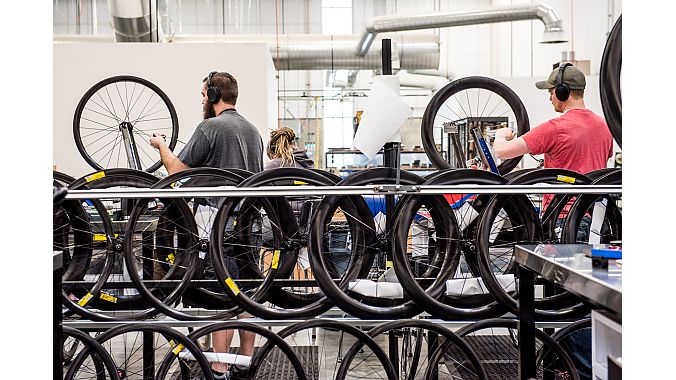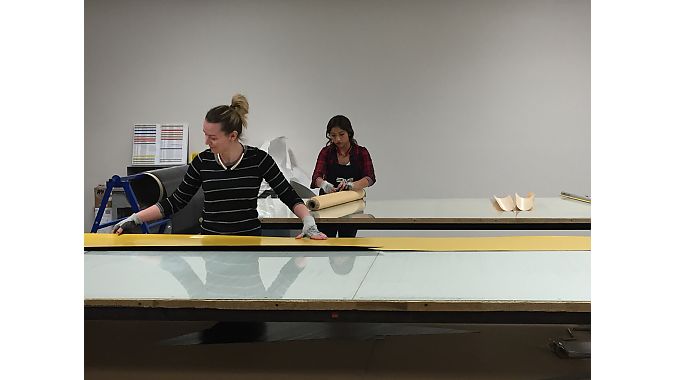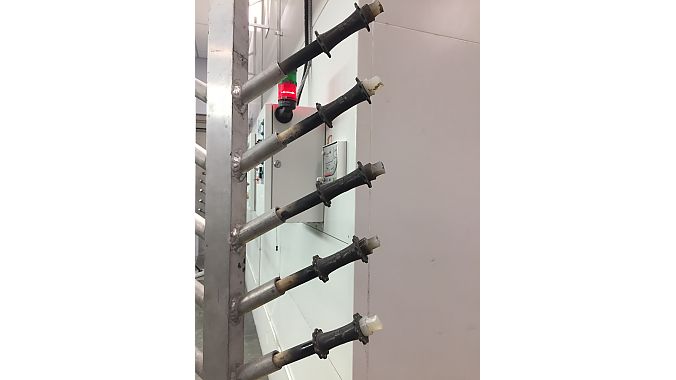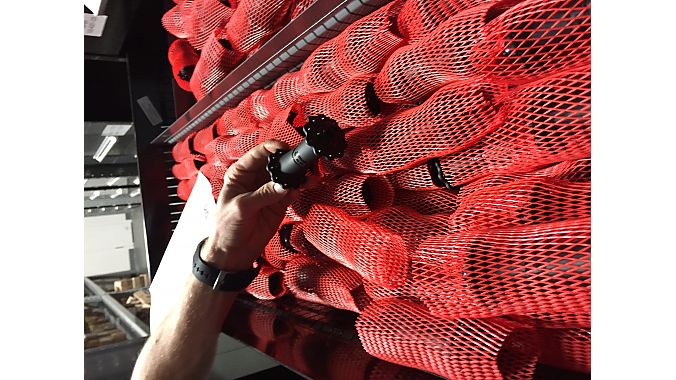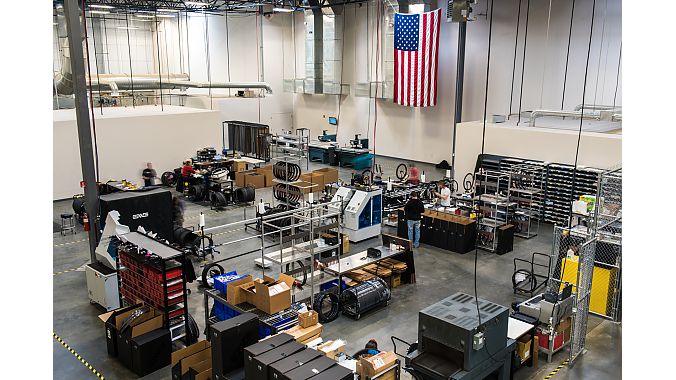OGDEN, Utah (BRAIN) — Enve moved into its new building last October, but the wheel brand recently held its grand opening in conjunction with the North American Handmade Bicycle Show.
From 33,000 square feet at its old building, Enve more than doubled its space with the new 80,000-square-foot facility, which was built from the ground up and specially designed for carbon wheel manufacturing. The building was in construction even before Enve was acquired by Amer Sports last February, said Jake Pantone, director of marketing for Enve.
Enve's parent, Amer Sports, has an office nearby, also in Ogden, where it houses its outdoor and winter sport brands including Salomon, Atomic, Suunto, Arc'teryx and, until recently, Mavic. Now Mavic is also under the Enve roof, with shared sales, customer service, dealer support and warranty. Only marketing and most of product development and engineering for Mavic is still handled out of France.
Some 168 employees work out of the new facility, and Pantone said that will ramp up to 180 by May. The building is part of a new business park that Ogden is hoping will be completely filled with cycling companies. Fizik, for example, is occupying a building nearby.
Among the advantages with the new setup is a more natural one-piece flow in the manufacturing. The old facility was modular, and that dictated that production be handled in batches. Now, with all the processes under one roof, the company said it will focus on just-in-time manufacturing and can handle a variety of rim types and designs at once. With exception of anodizing and decal production, all the manufacturing is done here for Enve's carbon wheels.
Enve produces all of its tooling including rim molds, wheel-racking systems, and even the work tables in its facility. It operates six CNC machines, five computer-controlled ovens for curing carbon wheels, a 900-square-foot freezer for storing of its materials (all carbon is store in-house now), vacuum tables and automated wheel-lacing machines. It also expanded its cut and ply room to four tables from two.
The efficiency of the workflow and expansion of machines and tooling enables Enve to go from 220-rim daily production (max) at the old facility to 250 rims per day at the new building. But production capacity is now as much as four times that, or 1,000 rims per day, Pantone said. Most of that (70 percent) is destined for the aftermarket. Only 30 percent of sales are to OEs; Santa Cruz is its biggest OE customer. "Our goal is never to exceed that," Pantone said, adding that aftermarket drives innovation.
Its warehouse can store as many as 10,000 rims, but Pantone said the goal is not to be heavy on inventory. With just-in-time manufacturing, Enve aims for no more than five to six weeks of inventory on the shelf.
Through the transition into the building, lead times have grown to six weeks. But Pantone said Enve wants to get that down to a 48-hour turnaround in the near future. "[Six weeks lead time] is not normal," he said. "But since the acquisition, Enve has expanded to new global markets so demand is greater, plus we're also moving into the busy season."
Pointing to racks full of rims, Pantone indicated that all of them are sold. Most of Enve sales are through brick-and-mortar retailers and distributors, he noted.
The shipping department also increased inline with global demand. Two full-size shipping containers can be accommodated on its loading docks and employees can pick and pack 100 orders per day, compared with 25 in the old facility.
Enve now has a warehouse in Asia as well as Europe through parent Amer Sports.
With the combination of the customer service and sales organizations of Mavic and Enve post-acquisition, more than half of the distributors were let go last year, which also hurt business. Now, Enve is rebuilding its sales.
Every Enve wheel starts as a roll at the new facility. Refrigerated trucks bring in prepreg carbon rolls and every wheel is individually cut based on orders, in a first in/first out cycle. "This allows us to make what's on demand and for a more efficient manufacturing process, and for us to carry less inventory," Pantone said.
We weren't allowed to take photos of the layup production, but 12 techs were working on setting the carbon inside the molds before hitting the oven.
Enve has invested significantly in automating as much of the process as possible. Autometrix cutting machines are programmed to cut the panels of carbon fiber for each rim or component kit; a machine also bolts all of the molds before heading into the oven; a robot sands wheels (requiring two techs to maintain and operate it compared to six techs with palm sanders); a machine also drills access holes into each wheel; and a robot laces each wheel. If demand ramps up, Enve also adds hand lacers to the production line.
Every wheel is still trued by hand by a wheel tech.
Two and a half years ago, Enve also brought painting in-house, hiring a former Serotta frame painter and setting up a full paint booth in its facility. The ability to paint in-house became important as Enve began producing more components such as stems, hubs and seatposts. Aside from rim manufacturing, Enve also is handling carbon hub assembly and stem manufacturing here.
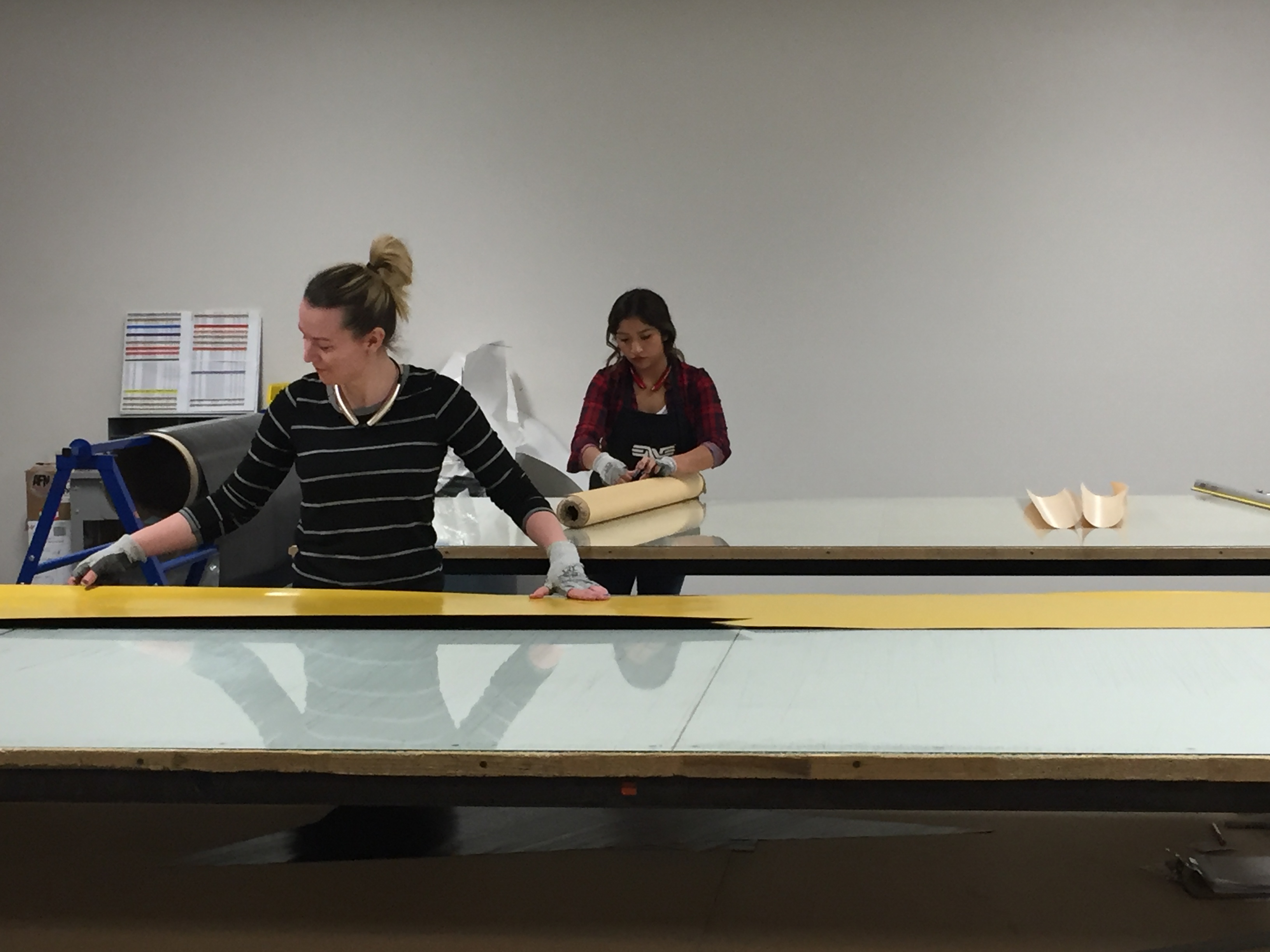
"We can strategically decide where we make stuff now," he said. "We may make more hubs here in the future both for mountain and road disc." Enve currently only manufactures a hub for its road rim brake wheel, but it stores all of the parts it specs for its wheels on-site as well.
The facility also houses Enve's test lab, where all rims undergo a variety of tests before going into production, and product is also pulled from inventory and tested after production to ensure quality.
But ultimately for Enve, more than the made-in-USA story, its Ogden manufacturing facility is important in that it allows for quality control, more innovative designs and a dynamic manufacturing process that responds to market demands and catches mistakes or problems earlier.
"We can turn off production to fix any problems and our customer service department is next to engineering, so if a customer calls, we know what's going on with the product," Pantone said.

